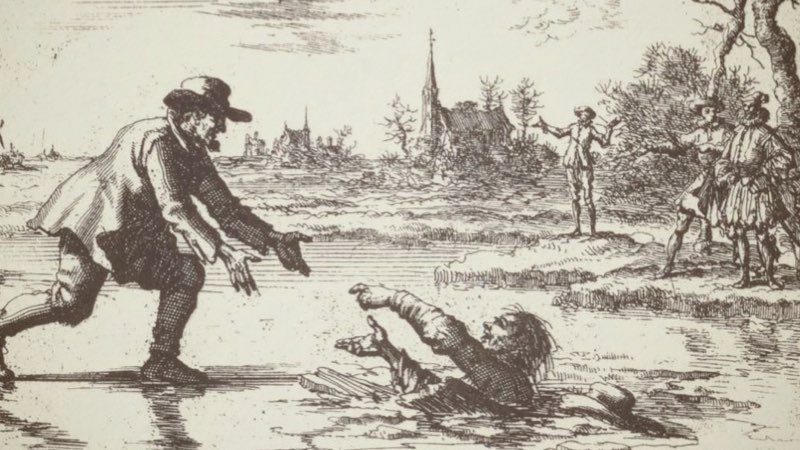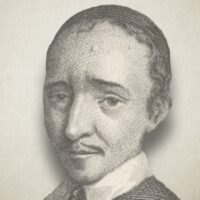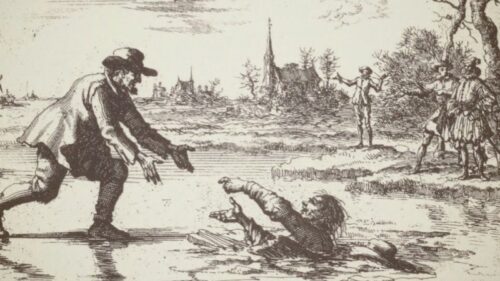
40. Matthew, the Evangelist
Matthew, The Holy Evangelist, Nailed To The Ground, And Beheaded At Nad-Davar, Under King Hytacus, About A.D. 70
Matthew, also called Levi, the son of Alpheus, was a publican in Capernaum. The publicans were detested by the Jews, because the latter did not consider themselves justly bound to pay toll or tribute to any foreign prince. Matt. 9:9; Mark 3:18; Luke 5:29. As touching the condition of publicans at that time, it was such that they generally exacted more from the people than was just; on which account they were shunned by the pious, so that open sinners, who were separated from the church, were compared to publicans. Matt. 9:11; 18:17.
When Matthew, or Levi, was still unconverted, and made his living in this unjust business, Christ met him with His grace, and commanded him to follow Him as a disciple. Obeying through an inward impulse, he forsook the customhouse, and, having prepared a great feast for the occasion of taking leave of his companions, he invited his fellow publicans, and also the Lord Jesus; apparently for an adieu, that they might find opportunity to become converted through the discourse of the Lord Jesus.
After this, Matthew immediately forsook all, and zealously followed his Lord, who had called him, and who, after He had more fully instructed him, placed him among the apostles, which office he, too, exercised among the Jews, till the death of Christ. Matt. 10:3; Luke 6:15.
Afterwards, when he was sent out to teach among the heathen, Ethiopia fell to his lot. But before he left Judea, he, through the illumination of the Holy Spirit wrote his Gospel, in the Hebrew language, and left it to them. Eitscb. lib. 5. cap. 1. Joh. Gys. Niceph. lib. 3, cap. 20. Secund. J. Gys.
In Ethiopia he accomplished much, with teaching as well as with miracles; and there he also left unto posterity after his death his written Gospel, from which it can easily be seen what faith he maintained, namely, the faith in Jesus Christ, the Son of God, that He became a real man, through the power of the Holy Ghost, in His mother Mary. Matt. 1st chapter, throughout.
History states that immediately after the death of King Aeglippus, who was attached to the Christians, his successor Hytacus, an unbelieving heathen, persecuted this apostle, and that at a certain time, when this pious apostle of Christ was teaching the church of God, he caused him to be apprehended and, as some write, nailed to the ground, and beheaded, in Naddavar, the capital of Ethiopia, where he is also buried, according to Venantius Fortunatus, who wrote, over a thousand years ago, “For the great city Naddavar shall restore to us at the last day the eminent apostle Matthew.” Gys. in Hist. Mart., fol. 12, col. 2. Also, Konst-tooneel van veertig, in the life of Matthew. Also, P. J. Twisck, Bybelsch Nosmbceck, fol. 65, col. 2, letter M. This writer states that he was fastened to the ground with darts, whereupon death ensued. Joh. Gys., from Venantius ortunalus, de Gaud. Vitce, lib. 7.
Thieleman J. Van Braght (1625-1664) was an Anabaptist who is best known for writing a history of the Christian witness throughout the centuries entitled “The Bloody Theater or Martyrs Mirror of the Defenseless Christians who baptized only upon confession of faith, and who suffered and died for the testimony of Jesus, their Saviour, from the time of Christ to the year A.D. 1660” (1660).
Thieleman J. Van Braght, Martyrs Mirror




